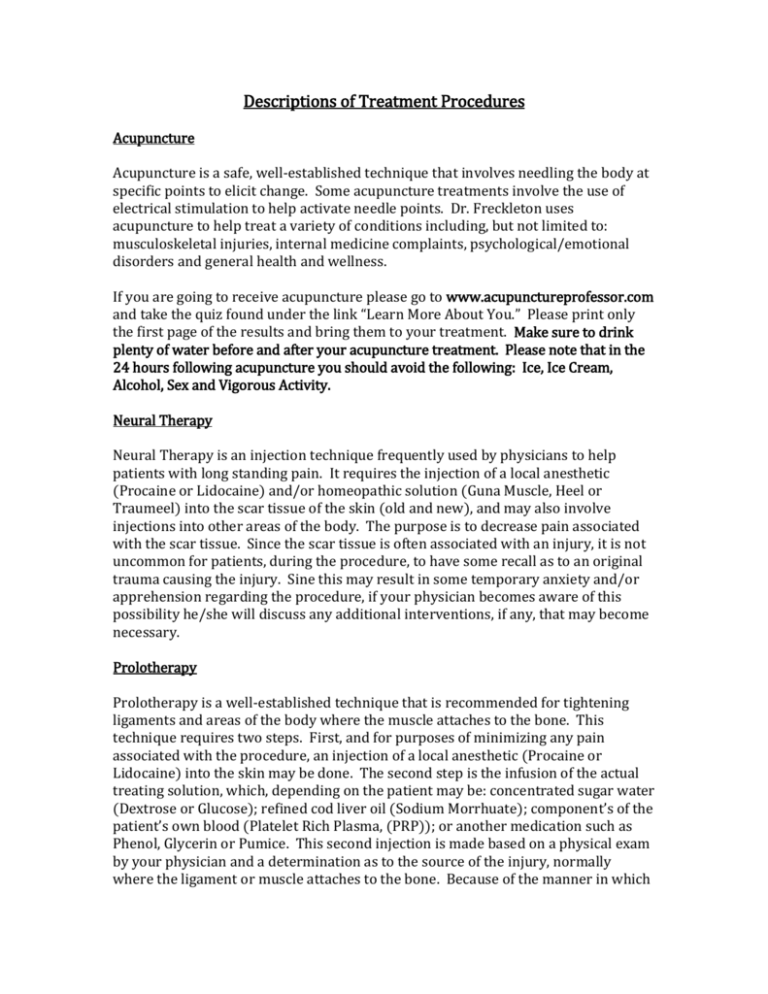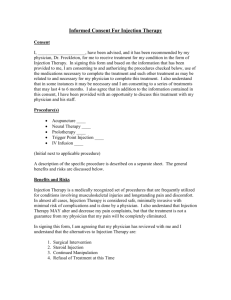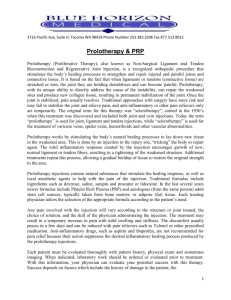Descriptions of Treatment Procedures
advertisement

Descriptions of Treatment Procedures Acupuncture Acupuncture is a safe, well-established technique that involves needling the body at specific points to elicit change. Some acupuncture treatments involve the use of electrical stimulation to help activate needle points. Dr. Freckleton uses acupuncture to help treat a variety of conditions including, but not limited to: musculoskeletal injuries, internal medicine complaints, psychological/emotional disorders and general health and wellness. If you are going to receive acupuncture please go to www.acupunctureprofessor.com and take the quiz found under the link “Learn More About You.” Please print only the first page of the results and bring them to your treatment. Make sure to drink plenty of water before and after your acupuncture treatment. Please note that in the 24 hours following acupuncture you should avoid the following: Ice, Ice Cream, Alcohol, Sex and Vigorous Activity. Neural Therapy Neural Therapy is an injection technique frequently used by physicians to help patients with long standing pain. It requires the injection of a local anesthetic (Procaine or Lidocaine) and/or homeopathic solution (Guna Muscle, Heel or Traumeel) into the scar tissue of the skin (old and new), and may also involve injections into other areas of the body. The purpose is to decrease pain associated with the scar tissue. Since the scar tissue is often associated with an injury, it is not uncommon for patients, during the procedure, to have some recall as to an original trauma causing the injury. Sine this may result in some temporary anxiety and/or apprehension regarding the procedure, if your physician becomes aware of this possibility he/she will discuss any additional interventions, if any, that may become necessary. Prolotherapy Prolotherapy is a well-established technique that is recommended for tightening ligaments and areas of the body where the muscle attaches to the bone. This technique requires two steps. First, and for purposes of minimizing any pain associated with the procedure, an injection of a local anesthetic (Procaine or Lidocaine) into the skin may be done. The second step is the infusion of the actual treating solution, which, depending on the patient may be: concentrated sugar water (Dextrose or Glucose); refined cod liver oil (Sodium Morrhuate); component’s of the patient’s own blood (Platelet Rich Plasma, (PRP)); or another medication such as Phenol, Glycerin or Pumice. This second injection is made based on a physical exam by your physician and a determination as to the source of the injury, normally where the ligament or muscle attaches to the bone. Because of the manner in which the treatment works, it may be necessary to do a series of injections in order to obtain the full benefit of treatment. Trigger Point Injection Trigger Point Injection is an injection technique frequently used to help patients with long standing pain resulting from an acute muscle injury, often associated with repetitive motion. As a result of the injury the muscle tires out quickly, puts additional strain on the joints associated with the muscle and can cause significant radiating pain. By treating the muscle, the additional strain on the joint is alleviated. The technique requires two steps. First, and for the purpose minimizing any pain associated with the procedure, an injection of local anesthetic (Procaine or Lidocaine) into the skin may be done. This may be followed with the injection of a local anesthetic (Procaine or Lidocaine) and/or homeopathic solutions (Guna Muscle, Heel or Traumeel) into the “trigger point” into the muscle or ligament. Intravenous Nutrient Therapy Intravenous Nutrient Therapy is an injection technique used to administer solutions intravenously. It is preferable to administer some nutrients intravenously because this type of process can raise serum concentrations of nutrients higher than with oral or muscular administration. This type of therapy is most commonly employed to reduce the amount of stress on the body, to boost energy, to stimulate the adrenal glands, to reduce pain, and to stimulate white blood cell production. The Therapy has also been shown useful as a supportive treatment with the following conditions: asthma, migraines, depression, hyperthyroidism, narcotic withdrawal, cardiovascular disease, upper respiratory infections, rhinitis, urticaria and athletic performance. The process of Intravenous Nutrient Therapy involves a single IV access followed by a slow push of nutrients, typically 15-20 minutes.





